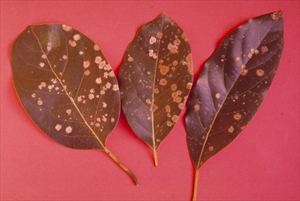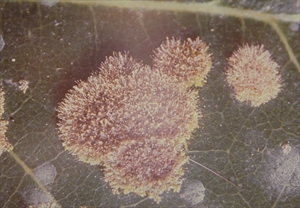Algal leaf spots, red rust (tea and coffee)
Pacific Pests, Pathogens and Weeds - Online edition
Pacific Pests, Pathogens & Weeds
Algal leaf spot (148)
Cephaleuros virescens, Cephaleuros minimus, Cephaleuros parasiticus
In Oceania, the species are recorded from American Samoa, Australia, Cook Islands, Federated States of Micronesia, Fiji, Niue, Palau, Papua New Guinea, Samoa, Solomon Islands, Tonga, and Vanuatu. Cephaleuros virescens is commonly recorded as other Cephaleuros species. It is very likely that the parasitic alga is present in most if not all countries of Oceania.
Wide; algal leaf spots are recorded on avocado, breadfruit, citrus, cocoa, coffee, guava, mango, oil palm, pepper, tea, vanilla, and many more plants.
Algal leaf spot occurs commonly in areas of high temperatures and rainfall, and where the host plants are not growing well. Poor nutrition, poor soil drainage and too much or too little shade, all create conditions that favour the disease.
On leaves, green to orange spots develop, which are round, 2-4 mmm diameter, flattened with furry growth and indistinct margins (Photo 1). The spots may merge. On young stems, the spots cause cracks in the bark and this can lead to dieback. In Samoa, this is commonly seen on cocoa seedlings planted without shade. On guava fruit, the spots are more irregular in size and shape, black, and cause distortions that affect quality.
Spores of the algae (called sporangia) are formed on the spots, giving them a furry look (Photo 2). The sporangia are spread by wind and also by water splash. They need water to germinate, but instead of producing a germ tube, each produces several motile spores which swim for a short time before they germinate and infect. In this way, they are similar to Phytophthora and downy mildews, which are also algae, not fungi.
Algal leaf spot is a minor disease of little economic importance, although it can result in leaf fall, dieback of branches, or distortion of fruits. Of the three species, Cephaleuro virescans is the most common. On many trees, it is the leaves of low hanging branches that show symptoms of the leaf spot.
Look for the green or orange, slightly raised, furry spots on the leaves that often merge to form large blotches. Look for black, irregular spots, on susceptible fruit, such as guava, and look for dieback on cocoa seedlings.
Except for very susceptible crops, such as guava when grown in areas of high rainfall, control measures are rarely needed. If they are, cultural control should be used to improve growing conditions.
CULTURAL CONTROL
-
Prune low hanging branches, which on many crops are the first to show signs of the disease.
-
Importantly, improve growing conditions, as follows:
-
Drainage: If the ground becomes waterlogged and this is affecting growth, improve drainage.
-
Nutrition: Consider the addition of mineral fertilizer, if the growth of the trees is poor.
-
Shade: If shade is too heavy or too little, make alterations, especially if dieback is occurring.
-
Tree density: If, for instance, guava trees are planted in a high rainfall area, ensure that plant density allows air circulation for rapid drying of leaves and fruit; and orientate the rows so that air moves easily through the crop.
-
CHEMICAL CONTROL
This is not an appropriate method of control.
AUTHORS Helen Tsatsia & Grahame Jackson
Information from Gerlach WWP (1988) Plant diseases of Western Samoa. Samoan German Crop Protection Project, Deutsche Gesellschaft für Technische Zusammenarbeit (GTZ) Gmbh, Germany; and Home & Garden Information Center (2017) Algal leaf spot. Clemson University Cooperative Extension Service. (https://hgic.clemson.edu/factsheet/algal-leaf-spot/); and from Algal leaf spot (undated) CTAHR, University of Hawai'i at Manoa. (https://www.ctahr.hawaii.edu/nelsons/glossary/Algal_leaf_spot.htm). Photos 1&2 Kohler F, et al. (1997) Diseases of cultivated crops in Pacific Island countries. South Pacific Commission. Pirie Printers Pty Limited, Canberra, Australia.
Produced with support from the Australian Centre for International Agricultural Research under project PC/2010/090: Strengthening integrated crop management research in the Pacific Islands in support of sustainable intensification of high-value crop production, implemented by the University of Queensland and the Secretariat of the Pacific Community.





